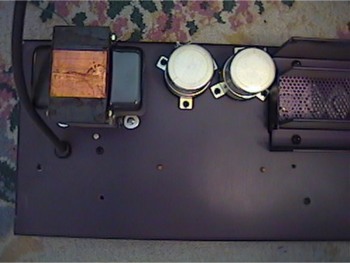The Lab Series L5 Guitar Amp
By Paul Marossy
Last updated 7/23/11
This amp is the secret weapon of two guitarists that I like,
Allan Holdsworth and Ty Tabor. You can hear the L5 amp on Holdsworth's first few albums and the first few King's X albums
feature Ty Tabor playing an L5. I always thought Tabor's amp sounded great - lot's of gain and crunch. I was very surprised
to find out that Ty played one of these amps. I always assumed that he used a tube amp! Around the time that Holdsworth
was on his "Tokyo Dream" tour in Japan, you can see Holdsworth playing thru a pair of L5s for his distortion tone and a
pair of silverface Fender Twin Reverbs for his clean tones - two great sounding amps. B.B. King is also
a user of this amp. The clean tones are also very nice, too.
Ordinarily, I would not recommend a solid state amp to anyone, but this is one of the rare occassions
where I actually would recommend a solid state amp, because these amps have a great tone. They are well designed and are
also pretty reliable amps. I was storing this particular
amp for a friend for a couple of months and thought I would do a little write up on it while I had it in my possession.

|
This is the front of the amp. It's a 100 watt twin, two channel amp with some cool features. |

|
Controls on the left side of the front panel are for Channel 1 and are pretty basic - just a volume, bass, mid and treble control. Most people aren't too excited about this channel, although it might be fine for guitar pedals and such. The EQ here is more or less like the classic Fender tonestack. |

|
The controls for Channel 2 are a little more
versatile and interactive. There is a volume, bass, frequency, mid, treble, multifilter and reverb control. This
channel is what most people like and use. The EQ is an active type EQ with a parametric midrange control and an adjustable
filter helps to shape your tone even more. There is also a bright switch to the left of the volume control. The multifilter is essentially a six-band EQ with fixed settings, where you control only how much of the signal thru it gets mixed back with the main signal - sort of like a flanger's comb filter with the sweep set to zero. The frequency centers are at 1000Hz, 1370Hz, 1900Hz, 2630Hz, 3630Hz and 5000 Hz. The reverb sounds pretty good except at extreme settings, but that is the case with most reverb circuits. |

|
There is also an onboard compressor that can be used to one's liking. The switch between the two knobs turns the compressor circuit on/off. You can really get a pretty wide range of sounds with all of these controls at your disposal. |

|
Here is a view of the back of the amp. The 12" speakers were made by an unidentified manufacturer. |

|
There are some code numbers on the speakers. With a little research, one could determine who manufactured them. I have recently been told by someone that the original speaker manufacturer for the example shown here, "137", was Chicago Telephone Supply (CTS). |

|
Here is a peek at the inside of the chassis. There is a 120VAC accessory outlet for powering a pedalboard or other device using 120V AC power. |

|
This is the power supply PCB. Notice the internal fuses. The rest of the PCBs are mounted directly behind the controls. |

|
To the right of the power supply PCB, there are 10 power transistors. |

|
At the underside of the chassis, where the power transistors are, there is a ventilated cover and very large heatsink to dissipate excess heat from the power transistors. |

|
Here is the power transformer and large can type power filter caps. |